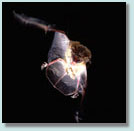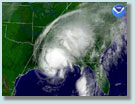| |
 |
 |
 |
|
 |
 |
 |
 |
 |

|
 |
 |
| |
 |
"Moon
Illusion" Still Confounds Scientists
|
 |
| |
 Walking
along an open road on a clear, cool, windy
Halloween evening, you notice the sun
as it sets and the sky turning dark. Suddenly,
you feel a presence. You turn sharply.
Over the horizon, a large yellowish ball
appears. Has Halloween come a-haunting?
No, it's only the moon. But, why does
it look so huge? We know the moon disc
is the same size whether on the horizon
or high in the sky. The larger horizon
moon is an illusion. The phenomenon has
been known to astronomers since before
the second century A.D., yet scientists
still debate the possible reasons for
this "moon illusion." Lloyd
Kaufman, a Long Island University research
scientist and retired New York University
professor of psychology and neuroscience,
has teamed up with his son, physicist
James Kaufman of IBM, in new research
for the National Science Foundation (NSF).
The pair will test the "apparent distance"
theory, determining whether or not perceived
distance is linked with physical distance. Walking
along an open road on a clear, cool, windy
Halloween evening, you notice the sun
as it sets and the sky turning dark. Suddenly,
you feel a presence. You turn sharply.
Over the horizon, a large yellowish ball
appears. Has Halloween come a-haunting?
No, it's only the moon. But, why does
it look so huge? We know the moon disc
is the same size whether on the horizon
or high in the sky. The larger horizon
moon is an illusion. The phenomenon has
been known to astronomers since before
the second century A.D., yet scientists
still debate the possible reasons for
this "moon illusion." Lloyd
Kaufman, a Long Island University research
scientist and retired New York University
professor of psychology and neuroscience,
has teamed up with his son, physicist
James Kaufman of IBM, in new research
for the National Science Foundation (NSF).
The pair will test the "apparent distance"
theory, determining whether or not perceived
distance is linked with physical distance.
Read
the full story. ... posted
10/30/02
|
|
 |
Tiger
Moths Use Sonic Defense to Trick Bats |
 |
| |
 As
a bat zips through the night sky, it sends
out high-pitched squeaks, bouncing sound
waves off of objects and unsuspecting
prey. While most insect victims would
have trouble fighting back, many dive
and loop to avoid enemies, and some have
the added advantage of being poisonous.
Yet, in the dark, the bright warning colors
of most toxic insects are lost on predators.
Now, some researchers suspect one type
of moth may have a way of effectively
broadcasting its toxicity -- the insect
produces high-pitched sounds of its own.
Tiger moths have a special clicker called
a tymbal built into their thorax. When
they fly, the moths click their tymbal
to produce a distinct sound that seems
to keep bats at bay. As
a bat zips through the night sky, it sends
out high-pitched squeaks, bouncing sound
waves off of objects and unsuspecting
prey. While most insect victims would
have trouble fighting back, many dive
and loop to avoid enemies, and some have
the added advantage of being poisonous.
Yet, in the dark, the bright warning colors
of most toxic insects are lost on predators.
Now, some researchers suspect one type
of moth may have a way of effectively
broadcasting its toxicity -- the insect
produces high-pitched sounds of its own.
Tiger moths have a special clicker called
a tymbal built into their thorax. When
they fly, the moths click their tymbal
to produce a distinct sound that seems
to keep bats at bay.
Image courtesy: William Conner and
Nickolay Hristov, Wake Forest University
Read
the full story . ... posted
10/30/02
|
|
 |
Researchers
Get First Look into Antimatter Atoms
|
 |
| |
 It
seems like the stuff of science fiction,
but NSF-sponsored researchers working
at CERN, the European Organization for
Nuclear Research, have probed the properties
of whole atoms of antimatter, the "mirror
image" of matter, for the first time.
Their results provide the first look into
the inside of an antimatter atom and are
a big step on the way to testing standard
theories of how the universe operates.
Fast-moving or "hot" antimatter has been
created for years, but previous hot anti-atoms
were annihilated by collisions with matter
before they could be studied. Last year
the ATRAP (for Antihydrogen Trap) team
led by Gerald Gabrielse of Harvard University
announced they'd pioneered methods of
slowing down negatively charged antiprotons
and combining them with slow positrons,
the positively charged antimatter equivalent
of electrons, to create an environment
for forming the simplest possible anti-atom:
antihydrogen. Now the team has made the
first measurements of a complete antihydrogen
atom. It
seems like the stuff of science fiction,
but NSF-sponsored researchers working
at CERN, the European Organization for
Nuclear Research, have probed the properties
of whole atoms of antimatter, the "mirror
image" of matter, for the first time.
Their results provide the first look into
the inside of an antimatter atom and are
a big step on the way to testing standard
theories of how the universe operates.
Fast-moving or "hot" antimatter has been
created for years, but previous hot anti-atoms
were annihilated by collisions with matter
before they could be studied. Last year
the ATRAP (for Antihydrogen Trap) team
led by Gerald Gabrielse of Harvard University
announced they'd pioneered methods of
slowing down negatively charged antiprotons
and combining them with slow positrons,
the positively charged antimatter equivalent
of electrons, to create an environment
for forming the simplest possible anti-atom:
antihydrogen. Now the team has made the
first measurements of a complete antihydrogen
atom.
Read
the full story . ... posted
10/30/02
|
|
 |
Augmented
Reality Brings Dinosaurs into the 21st
Century
|
 |
| |
 Paleontologists
and computer scientists have joined forces
to paint fossils with digital flesh and
create dynamic models that reveal how
dinosaurs may have looked, walked and
attacked prey. Called "augmented reality"
(AR), researchers have used the new techniques
to fit muscles onto a predator's jawbone
and to interpret a mysterious feature
in dinosaur footprints. National Science
Foundation (NSF)-supported paleontologists
Stephen Gatesy of Brown University and
Lawrence Witmer of Ohio University collaborated
with Oliver Bimber of Bauhaus University
in Germany and colleagues at the Mitsubishi
Electronic Research Laboratory in Cambridge,
Massachusetts, and the Fraunhofer Center
for Research in Computer Graphics in Providence,
Rhode Island, to develop augmented reality's
paleontology applications. Paleontologists
and computer scientists have joined forces
to paint fossils with digital flesh and
create dynamic models that reveal how
dinosaurs may have looked, walked and
attacked prey. Called "augmented reality"
(AR), researchers have used the new techniques
to fit muscles onto a predator's jawbone
and to interpret a mysterious feature
in dinosaur footprints. National Science
Foundation (NSF)-supported paleontologists
Stephen Gatesy of Brown University and
Lawrence Witmer of Ohio University collaborated
with Oliver Bimber of Bauhaus University
in Germany and colleagues at the Mitsubishi
Electronic Research Laboratory in Cambridge,
Massachusetts, and the Fraunhofer Center
for Research in Computer Graphics in Providence,
Rhode Island, to develop augmented reality's
paleontology applications.
Image courtesy: Oliver Bimber, Bauhaus
University, Germany (formerly of Fraunhofer
Center for Research in Computer Graphics
in Rhode Island), Stephen M. Gatesy, Brown
University, Lawrence M. Witmer, Ohio University,
Ramesh Raskar, Mitsubishi Electric Research
Laboratories, Massachusetts, and L. Miguel
Encarnação, Fraunhofer CRCG.
Read
the full story . ... posted
10/30/02
|
|
 |
Envision
This: Science Photographer Felice Frankel
to Present a Lecture; NSF Will Web Cast
Live |
 |
| |
 NSF
will host and web cast a lecture on "Envisioning
Science: The Design and Craft of the Science
Image" by science photographer Felice
Frankel on Oct. 28.
Frankel is a research scientist in the
School of Science at the Massachusetts
Institute of Technology, Director of the
Envisioning Science Project, and the author
of two books about communicating science
through imagery. The lecture coincides
with an exhibit of her work at NSF. The
live web cast will bring the event to
anyone with Internet access. Web viewers
will need a RealPlayer Plug-in that can
be downloaded for free. The lecture and
web cast will begin at 1:30 pm. NSF
will host and web cast a lecture on "Envisioning
Science: The Design and Craft of the Science
Image" by science photographer Felice
Frankel on Oct. 28.
Frankel is a research scientist in the
School of Science at the Massachusetts
Institute of Technology, Director of the
Envisioning Science Project, and the author
of two books about communicating science
through imagery. The lecture coincides
with an exhibit of her work at NSF. The
live web cast will bring the event to
anyone with Internet access. Web viewers
will need a RealPlayer Plug-in that can
be downloaded for free. The lecture and
web cast will begin at 1:30 pm.
Image © Felice Frankel
Read
more. ... posted
10/25/02
|
|
 |
The
Solution to Dissolution |
 |
| |
 How
many water molecules does it take to dissolve
an acid? Although this may sound like
a joke from a Mensa meeting, it's a fundamental
problem for chemists. Now with the help
of a powerful laser, NSF-sponsored researcher
A. Welford Castleman, Jr. of Penn State
University and colleagues have found the
answer: Five. Knowing how substances dissolve
is a basic chemistry problem that's key
to processes ranging from chemical reactions
in the body to depletion of the ozone
layer. Scientists have puzzled over the
process for over one hundred years and
theorists had recently predicted that
about four molecules of water were necessary
to break an acid molecule into two charged
pieces. Until now, though, there was no
experimental evidence to compare with
theory. How
many water molecules does it take to dissolve
an acid? Although this may sound like
a joke from a Mensa meeting, it's a fundamental
problem for chemists. Now with the help
of a powerful laser, NSF-sponsored researcher
A. Welford Castleman, Jr. of Penn State
University and colleagues have found the
answer: Five. Knowing how substances dissolve
is a basic chemistry problem that's key
to processes ranging from chemical reactions
in the body to depletion of the ozone
layer. Scientists have puzzled over the
process for over one hundred years and
theorists had recently predicted that
about four molecules of water were necessary
to break an acid molecule into two charged
pieces. Until now, though, there was no
experimental evidence to compare with
theory.
Read
the full story . ... posted
10/25/02
|
|
 |
Hurricane
Isidore Proves Perfect Subject for Study
of Rapidly Intensifying Storms |
 |
| |
 The
season's second tropical whirlwind to
reach hurricane strength gave hurricane
hunters the opportunity to monitor and
measure a tropical storm as it rapidly
intensifies. Supported by NSF, scientist
Nick Shay of the University of Miami,
along with atmospheric researcher Peter
Black of NOAA's hurricane research division,
are studying how deep layers of warm surface
water in the ocean help hurricanes to
rapidly intensify - one of the most difficult
situations to forecast and one of the
most dangerous for coastal residents. The
season's second tropical whirlwind to
reach hurricane strength gave hurricane
hunters the opportunity to monitor and
measure a tropical storm as it rapidly
intensifies. Supported by NSF, scientist
Nick Shay of the University of Miami,
along with atmospheric researcher Peter
Black of NOAA's hurricane research division,
are studying how deep layers of warm surface
water in the ocean help hurricanes to
rapidly intensify - one of the most difficult
situations to forecast and one of the
most dangerous for coastal residents.
Image courtesy: NOAA
Read
the full story . ... posted
10/18/02
|
|
 |
NSF
Grantees Awarded 2002 Nobel Prizes for
Economics, Chemistry, and Physics |
 |
| |
 Daniel
Kahneman of Princeton University and Vernon
L. Smith of George Mason University were
awarded the Nobel Prize for Economics,
and John B. Fenn shares the Nobel Prize
for Chemistry with Japan's Koichi Tanaka
and Kurt Wütrich of Switzerland,
the Royal Swedish Academy of Sciences
announced on Oct. 9th. Previously, on
Oct. 8, the academy awarded Raymond Davis,
Jr., of the University of Pennsylvania
and Riccardo Giacconi of Associated Universities,
Inc., the 2002 Nobel Prize in Physics,
along with Masatoshi Koshiba of Japan.
NSF has supported Kahneman, Smith, Fenn,
Davis, and Giacconi. Daniel
Kahneman of Princeton University and Vernon
L. Smith of George Mason University were
awarded the Nobel Prize for Economics,
and John B. Fenn shares the Nobel Prize
for Chemistry with Japan's Koichi Tanaka
and Kurt Wütrich of Switzerland,
the Royal Swedish Academy of Sciences
announced on Oct. 9th. Previously, on
Oct. 8, the academy awarded Raymond Davis,
Jr., of the University of Pennsylvania
and Riccardo Giacconi of Associated Universities,
Inc., the 2002 Nobel Prize in Physics,
along with Masatoshi Koshiba of Japan.
NSF has supported Kahneman, Smith, Fenn,
Davis, and Giacconi.
Read
the full story . ... posted
10/15/02
|
|
 |
Math
and Science Partnership Awards Announced;
K-12, Higher Education Institutions Unite
in Effort to Boost Learning |
 |
| |
 The
National Science Foundation (NSF) has
announced 24 awards under the new Math
and Science Partnership (MSP) program
-- an anticipated investment of $240 million
over five years in projects to improve
the achievement of K-12 students in science
and mathematics. The Department of Education
(ED), an NSF partner in this effort, is
co-funding two projects involving state
education agencies. "These partnerships
will become part of a broad national network
of interconnected sites that will share
successful instructional strategies, entice
and train competent science and math teachers
and improve learning for millions of students,"
said NSF Director Rita Colwell. "One of
the key outcomes of these grants will
be the improved content knowledge of teachers
of mathematics and science in districts
across America," said U.S. Secretary of
Education Rod Paige. The
National Science Foundation (NSF) has
announced 24 awards under the new Math
and Science Partnership (MSP) program
-- an anticipated investment of $240 million
over five years in projects to improve
the achievement of K-12 students in science
and mathematics. The Department of Education
(ED), an NSF partner in this effort, is
co-funding two projects involving state
education agencies. "These partnerships
will become part of a broad national network
of interconnected sites that will share
successful instructional strategies, entice
and train competent science and math teachers
and improve learning for millions of students,"
said NSF Director Rita Colwell. "One of
the key outcomes of these grants will
be the improved content knowledge of teachers
of mathematics and science in districts
across America," said U.S. Secretary of
Education Rod Paige.
Read
the full story . ... posted
10/3/02
|
|
 Top
of Page Top
of Page
|
|
|
 |
 |
 |
 |
 |
 |
 |
 |
|
 |
 |
 |
|
|
| |
|
|
| |
 |
National Science Foundation
Office of Legislative and Public Affairs
4201 Wilson Boulevard
Arlington, Virginia 22230, USA
Tel: 703-292-8070
FIRS: 800-877-8339 | TDD: 703-292-5090
|
 |
|
|
|

